It’s officially the first day of spring, and, despite the odd flurries of snow and a forecast for rain and more rain , the skies graciously cleared enough to show just a little watery blue.
In Vancouver’s changeable weather, there’s one cookbook that I can count on to consistently bring the lush, tropical warmth of Kerala to my kitchen at any time – Grains, Greens, and Grated Coconuts©. A perfect blend of historical perspective, personal anecdotes, and impeccably researched and written vegetarian recipes from the kitchens of the Kochi royal family, GG&GC truly is a timeless classic.
I’m honoured to have the first guest post on this blog by the author, my friend, Ammini Ramachandran.
Kerala Puttus
by Ammini Ramachandran
Reading Shalini’s post – Oduputtu: aromatherapy for the cook – brought back memories of a favorite breakfast dish of Kerala with a similar name – puttu. Just as with Coorg cuisine, Kerala cuisine is deeply rooted in rice. And similarly, there are several Kerala dishes that end with the suffix puttu. The one major difference is that Kerala puttus are prepared with rice flour, wheat flour, ragi flour or grated tapioca, but never with a batter. They have a crumbly texture.
Puttu
Log-shaped puttu is made by steaming roasted rice flour and fresh coconut in metal tubes fitted over a pot – puttu kudam or puttu maker. Either white rice flour or red rice flour are used make puttu. Traditionally, puttu was steamed in bamboo logs, which imparted a pleasant earthy aroma. The dry, flaky puttu is served with kadala curry (a spicy curry of brown chickpeas simmered in a sauce of fresh roasted coconut, coriander and red chilies, and seasoned with mustard seeds and curry leaves), or fried pappadams, and finger bananas.
Kalaputtu
Kalaputtu is puttu steamed in an idli pathram, the steamer for making idlis. It is a large vessel with a tight lid and a stack of idli plates with small holes. When making kalaputtu only one idli plate is enough. Roasted rice flour, salt and coconut and mixed with a little water to a crumbly texture and steamed to make kalaputtu.
Chiratta Puttu
When the same puttu mix is steamed in a half shell of a coconut it is called chiratta puttu. Pierce a hole at the bottom of the coconut shell, fill it with puttu mix and top with freshly grated coconut. Cover and place over the hole of a pressure cooker and steam.
Thirattipittu:
This is the sweet version of puttu, but no coconut is used in it. Addition of jaggery, ghee and cardamom gives it an enticing aroma.
Kappa Puttu (Tapioca Puttu)
Cassava, or tapioca, was brought to Kerala by the Portuguese in the fifteenth century. During the famine and rice shortage in Kerala more than a century ago, tapioca gained much prominence. Kappa puttu served with spicy fish curry is considered a delicacy in southern Kerala. Grated fresh tapioca mixed with roasted rice flour, salt and coconut is steamed in coconut shells or puttu maker to make this version.
Erachi Puttu
In this non-vegetarian version of puttu, the puttu mix is layered with minced meat or chicken cooked with salt, shallots, ginger, garlic, green chilies, curry leaves, turmeric, coriander, cinnamon, and fennel. This puttu can be made either in a coconut shell or puttu maker. This version of puttu is served without any accompanying curry.
Southeast Asian puttus
Puttu is not exclusive to south India. There are Malay, Indonesian, Singaporean, and Fujian Chinese versions of sweet puttu. Roasted rice flour and fresh coconut are common in all of them. The rice flour is roasted with pandan leaves torn into pieces, which impart a particular flavor to rice. These leaves are sifted out before proceeding with the recipe. In Singapore and Malaysia it is called putu piring and in Indonesia it is putu bambu. Both have filling made of palm sugar and garnish of coconut. The filling in the Chinese version kueh tutu contains grated and toasted coconut or peanut or a combination of both.
Shalini mentioned that in making oduputtu the clay pan is rubbed with a lump of resin called banda that imparts a delicate fragrance to it. She goes on “the name ‘banda’ conjures up images of the famed spice islands in Indonesia. Is there a link?”
I too think perhaps there was a connection. Long before the colonial era, Southeast Asian, Chinese, Arab and Indian traders pioneered an all-sea route through the Indian Ocean and developed a flourishing international market for spices. Inscriptions dating back to the twelfth century AD reveal the presence of South Indian guilds in the ports of Southeast Asia and China. Perhaps the recipe for puttu also traveled with these ancient mariners (from where to where – I do not know) and local ingredients got incorporated into the recipes, and some of them traveled with them to their homelands, and eventually developed into various versions of puttu.
Kerala Puttu: Steamed Rice Flour and Fresh Coconut Logs
2 cups coarse rice flour
1½ cups freshly grated coconut
1 tablespoon ghee
Salt to taste
In a heavy skillet, dry roast the rice flour over medium heat, stirring continuously. After about five minutes remove from the stove, and let it cool. Add one cup of the grated coconut and salt, and mix well. Sprinkle a half-cup of water over the flour, a little at a time, and mix well. The trick in making real soft puttu is in the moisture content of rice flour. The rice flour mixture should be wet but not lumpy. Take a little of the flour mix between your index finger and thumb, press gently and let it fall gently. If it holds its form as it falls, the flour is damp enough. Stir in the ghee. Though not called for in the traditional recipe, it adds to the flakier texture of puttu.
Heat water in a puttu kudam. Insert the flat disk with holes at the bottom of the tube. Fill half of the tube with the prepared rice flour and coconut mixture. Sprinkle a tablespoon of the remaining coconut on top, and fill the rest of the tube with more rice and coconut mixture. Sprinkle on another tablespoon of grated coconut, cover the tube with the three-holed lid, and attach the tube to the pot of boiling water. Steam for six to eight minutes; when the puttu is cooked, steam will start coming through the holes on the lid. Remove the tube from the pot and open the lid. Using the handle of a large spoon, slowly push the puttu, and slide it onto a plate. Serve hot with kadalakari or fried pappadum and finger bananas.
Kadalakari: Spicy Chickpea Curry
This spicy Indian brown chickpea curry generally served with puttu also goes well with any type of flatbread. Garbanzo beans may be substituted for Indian brown chickpeas.
2 cups Indian brown chickpeas
½ teaspoon turmeric
½ tablespoon vegetable oil
1 cup freshly grated coconut
1 tablespoon coriander seeds
5 or 6 dried red cayenne, serrano, or Thai chilies (or less for a milder taste)
Salt to taste
For seasoning and garnish:
1 tablespoon vegetable oil
1 teaspoon mustard seeds
1 dried red cayenne, serrano, or Thai chili, halved
¼ teaspoon asafetida powder (optional)
12 to 15 fresh curry leaves
1 tablespoon finely chopped cilantro leaves
Soak chickpeas overnight in plenty of water. Rinse in several changes of water until the water runs clear, and drain. Place the chickpeas in a saucepan with four cups water and the turmeric powder, and bring it to a boil over medium-high heat. Cook until the chickpeas are very tender, approximately fifty minutes to one hour. Alternatively, you may cook the chickpeas in a pressure cooker (following the manufacturer’s instructions) for six to eight minutes to speed up the process.
Heat half a tablespoon of the oil in a skillet over medium heat, and fry the grated coconut, stirring constantly, until it turns golden brown. Add the coriander seeds and red pepper, and fry for another minute or two. Remove from the stove, and let it cool. In a blender, grind the coconut and spices with just enough water to make a thick, smooth puree. If there is excess water in the chickpeas, drain some of it. When the spice puree is stirred in, the curry should be fairly thick. Combine the spice puree and the chickpeas, add salt to taste, and simmer for six to eight minutes.
Heat oil in a skillet, and add the mustard seeds. When the mustard seeds start sputtering, add the halved red chili pepper, asafetida, and curry leaves. Remove it from the stove, and pour it over the kadalakari. Garnish with thinly chopped cilantro leaves. Cover and set aside for ten minutes, to allow flavors to blend. Serve hot with puttu.
Variation: Instead of using asafetida, substitute with half a cup of finely chopped onions that have been browned in a teaspoon of oil.
Thirattiputtu: For this sweet version, in a heavy skillet, dry roast 2 cups of rice flour over low to medium heat, stirring continuously until it is well roasted (five to six minutes). Remove from the stove, and let it cool to room temperature. Sprinkle half a cup of water over the flour, a few tablespoons at a time and mix thoroughly. It is ideal to use clean hands to mix the flour and water. It should be wet but not lumpy. Bring water to a boil in a heavy saucepan or a steamer. Spread a clean wet cloth over the steamer insert, and spread the rice flour over it. Cover and steam for fifteen to twenty minutes. Remove it from the stove, and spread on a platter to cool.
In a heavy skillet, mix one cup of jaggery with two tablespoons of water, and cook over medium heat to make a thick syrup of firm-ball consistency (approximately 245°F to 250°F on a candy thermometer). Remove the skillet from the stove, add the steamed rice flour, and mix thoroughly. Sprinkle two teaspoons of crushed cardamom, and four teaspoons of ghee, and mix well. Serve warm or at room temperature.
Some of you reading here may already know Ammini and be familiar with her work, but for those of you who are meeting her for the first time, I don’t think I can do better than direct you to her own website, Peppertrail.com. A former financial analyst who grows from strength to strength in her second career as a food writer and culinary historian, Ammini is also a regular contributor to the online magazine Zester Daily, where she showcases the subtle of sophistication of Kerala cuisine.

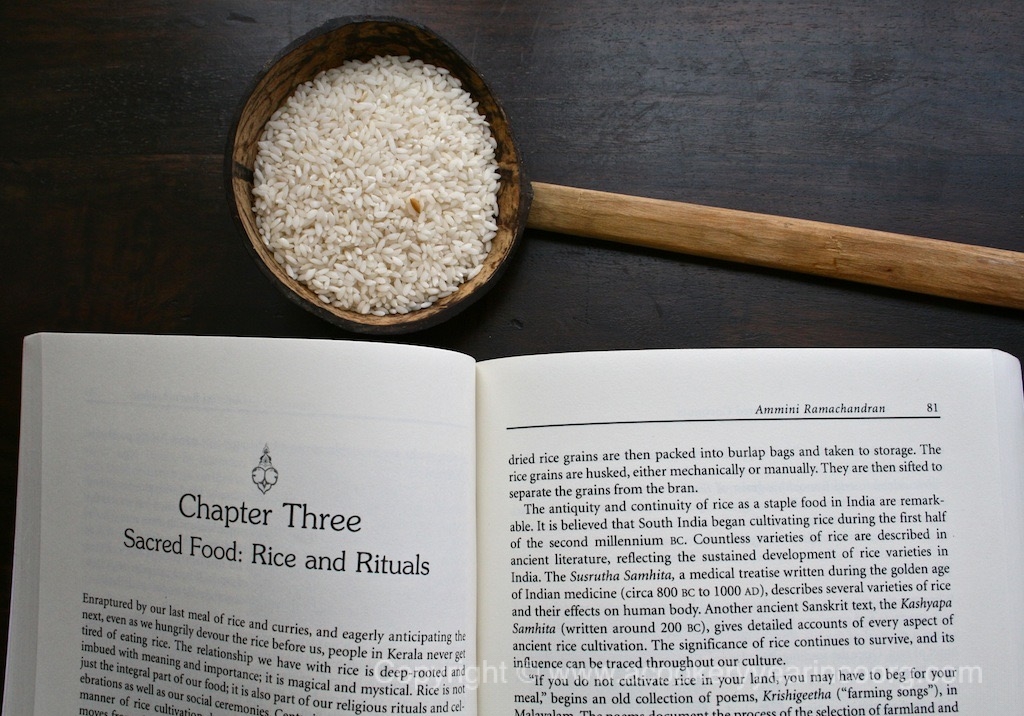
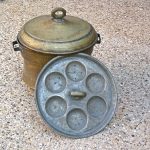
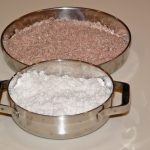
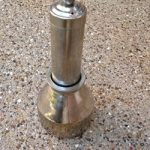
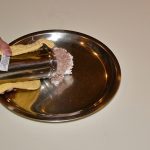
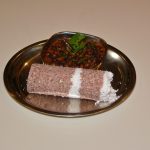
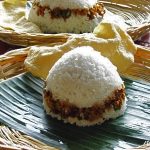
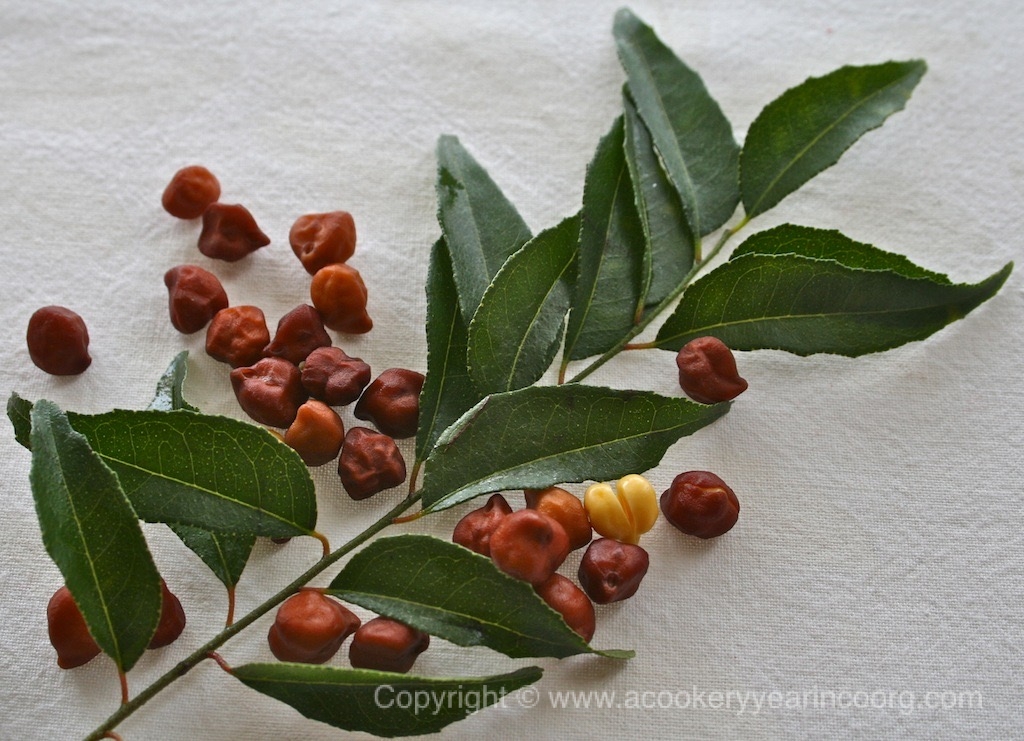
Thank you for that wonderful post, Ammini. I was so pleased to discover the Kerala puttu(s), and your kadalakari is one of my favourite recipes from the book. Though I follow your recipes mainly when making a vegetarian meal, I find myself dipping into the book to cook up dishes that sit in surprisingly well with our decidedly non-vegetarian fare!
Thank you Shalini and Ammini for this detailed post. I want to just run to the kitchen and make puttu and kadala curry!
Thanks for dropping by,Apolina! I now have a decent source for Kerala rice and flour,so more puttu for me 🙂
Shlini, it is an honor to write a post for your wonderful blog.
Thanks you “Mishmash” for allowing me to share your beautiful photograph of erachiputtu.
Apolina, hope you enjoy the puttu and kadala curry.